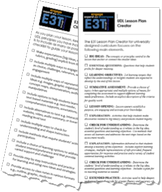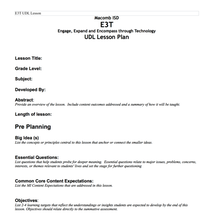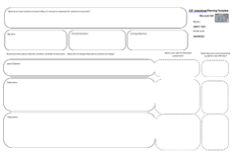Universal Design for Learning
Lesson Design

Good instruction begins with a good plan.
The E3T project works with teaching teams to develop sound Universally Designed Lesson Plans. The principles of Universal Design for Learning serve as the underlying framework for these lessons.
When universal design is applied to learning, learning supports are built into the curriculum for any student to use, reducing potential learning barriers for all students. Planning begins with the recognition that each learner is unique
With student diversity in mind, educators design instruction that anticipates the need for a variety of options and supports. From the start, options for interests, perception, learning strengths, language ability and motivation are built into the lesson. These options give the lesson flexibility. Students then select the options they need, resulting in instruction customized by the individual learner. When learner diversity is acknowledged and planned for, all learners will have an opportunity to make progress toward achieving and understanding the common core content.
Intentional Planning Flowchart
Learn More About our E3T Lesson Design
Designing the Learning Environment
- Crafting the Big Idea:
- The concepts or principles central to a lesson that anchor or connect the smaller ideas.
- Essential Questions:
- Questions that help students probe for deeper meaning. Essential questions relate to major issues, problems, concerns, interests, or themes relevant to students' lives and set the stage for further questioning.
- Learning Objectives:
- The understandings, insights or skills students are expected to develop by the end of this lesson.
Developing the Summative Assessment
The final assessment used to provide evidence that students have met the learning objective. It should provide choices related to interest and multiple, flexible means for completion that support learning preferences. All summative assessment assignments should include an explicit description of the criteria for quality work.
The opening activities establish a purpose, are engaging and activate student's prior knowledge. Lesson openers also include an explicit plan for sharing with students the learning objectives, summative assessment rubrics and learning outcome expectations.
Activities that enable students to make discoveries related to the big idea and that promote student inquiry. Note that this occurs prior to formal instruction or explanation.
Frequent Checks for Understanding
Activities that determine the student's level of understanding as it relates to the big idea, essential questions and learning objectives. Checks for understanding should include multiple means to demonstrate understanding, methods that assess all learners and describe the next steps you will take based on the assessment results.
Supportive and Inclusive Explanation
The plan for delivering the content in order for students to develop a mastery of the objectives. It should included: explicit learning strategies, multiple representations of information provided, direct instruction to address new vocabulary, frequent opportunities for response and practice, content summary, variety of student centered learning activities.
These activities help to deepen student understanding and provide for greater fluency and accuracy with new skills. Practice should include both supervised and unsupervised opportunities and have a clear purpose that’s shared with the learner. When possible, activities should be authentic and include multiple ways to practice new material.
Link to the tool E3T teachers use to create UDL Lessons.


